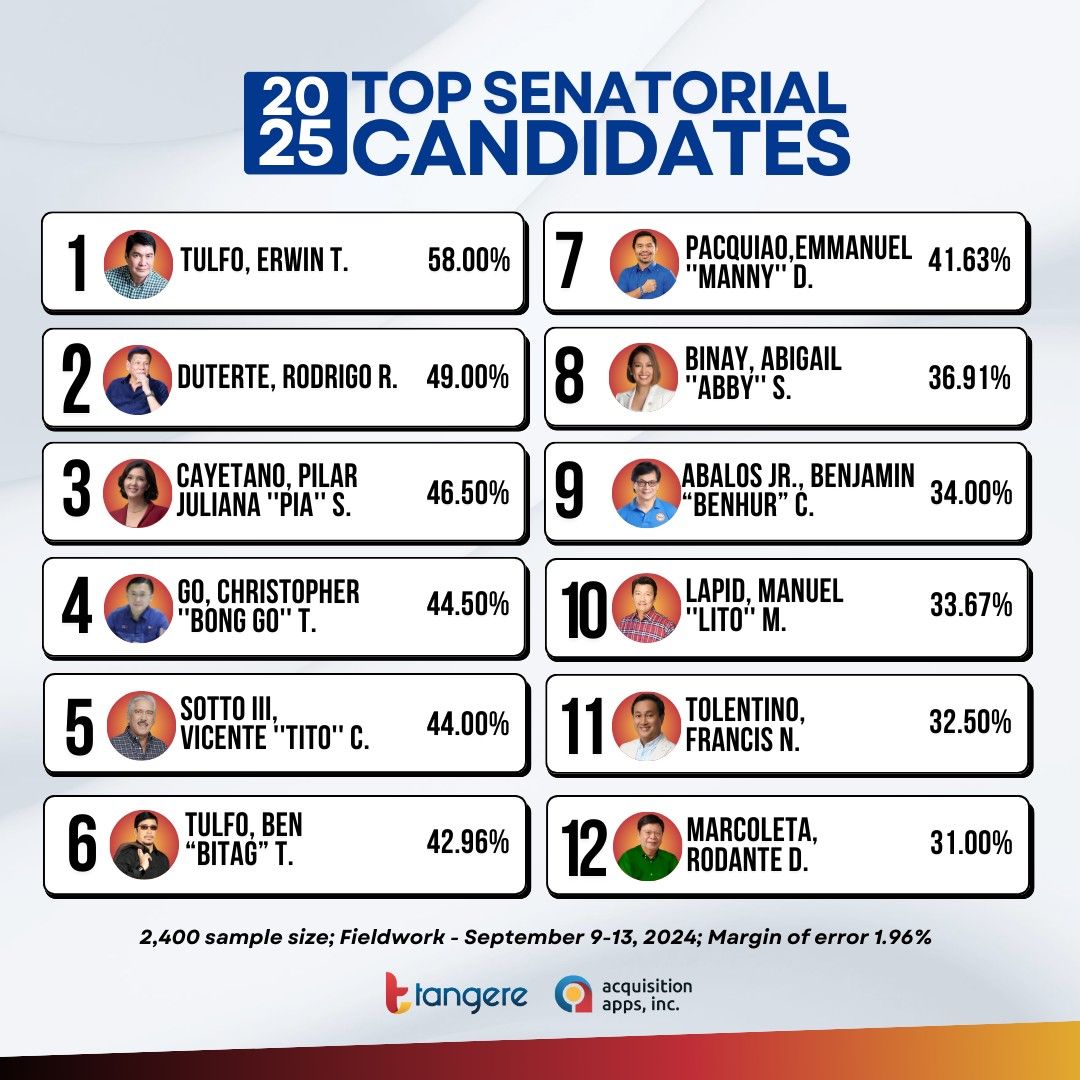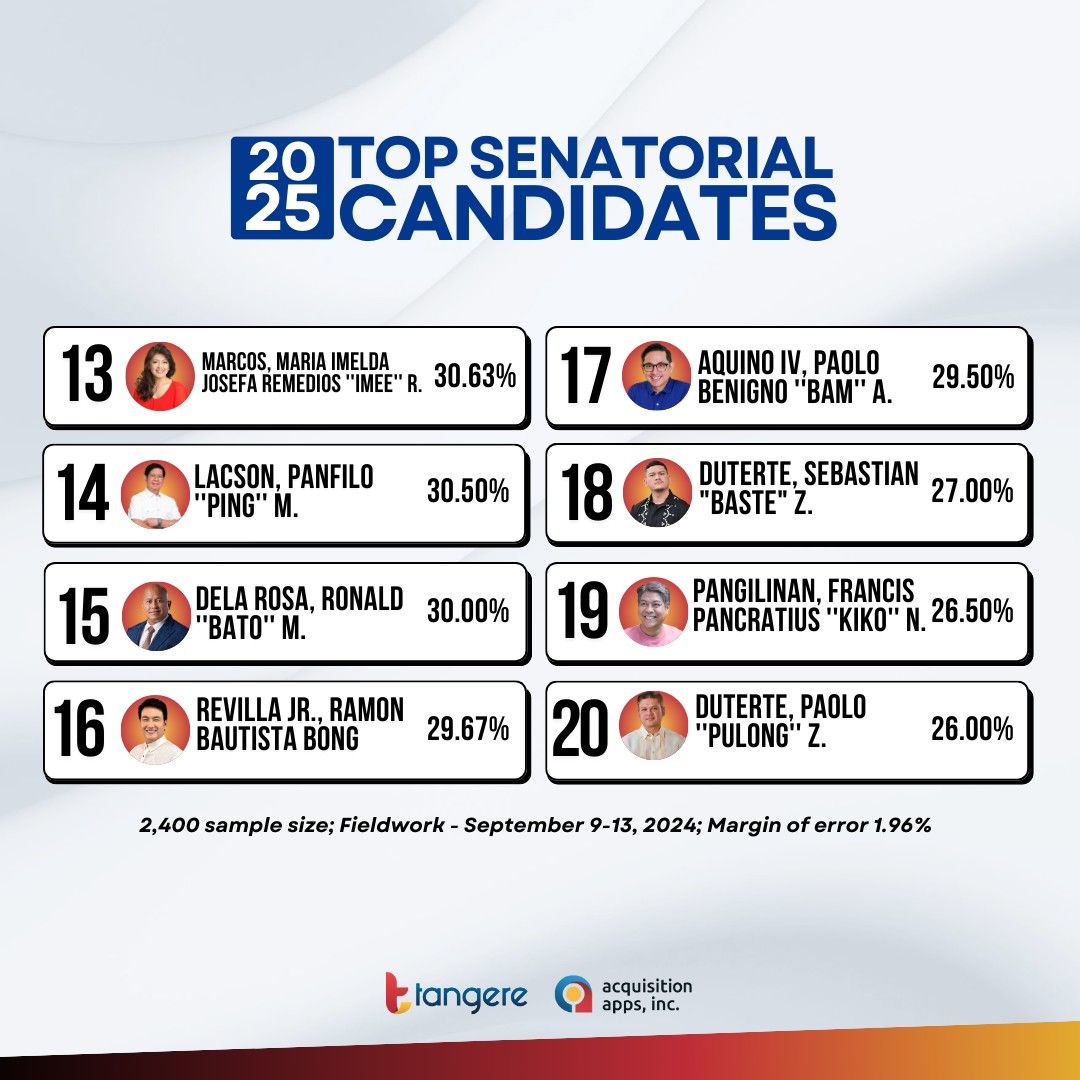Rep. Tulfo strengthens lead in September 2024 pre-senatorial election survey — Tangere
At A Glance
- The 2025 Tangere Senate Survey, conducted from Sept. 9 to 13, revealed that Tulfo received a voter preference of 58 percent, up from 56.29 percent in August.
- Former president Rodrigo Duterte remained in 2nd place.
- Makati City Mayor Abby Binay, Interior and Local Government Secretary Benjamin "Benhur" Abalos Jr., and Sagip Party-list Rep. Rodante Marcoleta were the biggest gainers in this month's survey.

ACT-CIS Party-list Rep. Erwin Tulfo has widened his lead in the latest pre-senatorial election survey results for potential candidates released by the market research firm Tangere.
The 2025 Tangere Senate Survey, conducted from Sept. 9 to 13, revealed that Tulfo received a voter preference of 58 percent, up from 56.29 percent in August.
Tangere said the party-list representative scored “very high” across all areas, age groups, and socio-economic classes.
Meanwhile, former president Rodrigo Duterte closely trailed Tulfo, showing a notable gain from 47.83 percent in August to 49 percent in September and maintaining his second-place ranking.
Tangere said that while the former president continued to benefit from support in Mindanao, there was a notable decline in voter preference in Northern Luzon, Southern Luzon, and Bicol Region.
Senator Pia Cayetano held onto third place with 46.5 percent of voter preference.
Senator Christopher “Bong” Go moved to fourth place in the September survey, from fifth in the August survey, with a voter preference of 44.5 percent.
Former Senate President Vicente “Tito” Sotto III, who was in fourth place in the previous survey, dropped to fifth with 44 percent.
Meanwhile, Rep. Tulfo’s brother, broadcaster Ben Tulfo, held the sixth spot with 42.96 percent voter preference.
Former Senator Manny Pacquiao remained in seventh place with 41.63 percent voter preference.
Makati City Mayor Abby Binay moved up to eighth place with a voter preference of 36.91 percent, followed by Interior and Local Government Secretary Benjamin “Benhur” Abalos Jr. in ninth place with 34 percent.
Senator Lito Lapid dropped eighth to 10th place, with 33.67 percent voter preference, while Senator Francis Tolentino remained in 11th place with 32.5 percent.
In 12th place is Sagip Party-list Rep. Rodante Marcoleta with 31 percent.
Tangere highlighted that Binay, Abalos, and Marcoleta were the biggest gainers in this month’s survey.
It explained that the increase in voter preference for Binay was driven by voters from Metro Manila, Central Luzon, and Calabarzon, and among those 26 to 35 years old.
Meanwhile, it said the increase in voter preference for Abalos was driven by voters 26 to 50 years old living in Metro Manila and Balance Luzon.
The recent surrender of Kingdom of Jesus Christ leader Apollo Quiboloy and the arrest of former Bamban, Tarlac Mayor Alice Guo contributed to voter preference for the DILG chief.
Moreover, the increase in voter preference for Marcoleta was driven by voters from Mindanao and Central Luzon.
It added that Marcoleta's prominence in the ongoing budget hearings of the Office of the Vice President also contributed to his rise.

Tangere also noted that three incumbent senators, two former senators, and former president Duterte’s son nearly made the top 12.
Senator Imee Marcos experienced a notable 3 percent decrease in her voter preference, dropping from 10th to 13th place, with a voter preference of 30.63 percent.
Tangere attributed the decline to reduced support from Mindanao.
Also narrowly missing the top 12 are former Senator Panfilo “Ping” Lacson (14th, 30.50 percent), Senator Bato Dela Rosa (15th, 30 percent), Senator Bong Revilla (16th, 29.67 percent), and former Senator Bam Aquino (17th, 29.5 percent).
Meanwhile, Davao City Mayor Baste Duterte continued his rise, receiving a 27 percent voter preference (18th place).
The survey was conducted through the mobile-based respondent application, with a sample size of 2,400 participants (+/- 1.96 percent margin of error at a 95 percent confidence level.
The sampling used a stratified random or quota-based method.
The was distributed throughout the Philippines as follows: 12 percent from the National Capital Region, 23 percent from Northern Luzon, 22 percent from Southern Luzon, 20 percent from Visayas, and 23 percent from Mindanao.